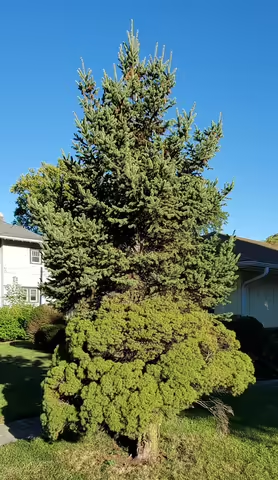There are many oddities of the plant world that are hard to pass up without some questions. Based on the perspective of the beholder, some of these strange phenomena may lead to either wonder or concern.
on occasion to dwarf-sized cultivars of
white spruce.
One plant that has fueled both questions of marvel and worry is the popular evergreen, the Dwarf Alberta Spruce (Picea glauca ‘Conica’). This plant has seen widespread use in the landscape due to its compact size and unique, fine-textured needles. With annual grown sometimes measured in mere inches, these slow-growing conifers seem to stay a manageable size for decades requiring little maintenance. Aside from a few pest issues and ill effects from environmental stress, since its not native to Illinois’ hot and humid climate, the plant often does surprisingly well with little effort from the gardener.
However, from time to time, one of these plants wields a monstrosity of a limb that takes over its canopy and rapidly grows into a behemoth of an evergreen. The needles on this limb are much larger, giving it a much coarser appearance and the amazing growth rate creates an incredibly unbalanced plant. It almost appears as if one large tree was plucked from its growing space and joined to the top of a dwarf specimen to create a Frankenstein-like plant with a massive top and tiny base.
Many homeowners think that a new tree has grown up the center of their dwarf evergreen and exploded out the top. This “new tree” is often pinned as the oddity, but, it’s the more normal part of what’s going on here.
Origins of Dwarf Alberta Spruce
To understand what’s happening, it helps to go back to the origins of Dwarf Alberta Spruce because this cultivar is the result of chance observation of a natural oddity.
In 1904, while waiting for a belated train near Banff National Park, two botanists from the Arnold Arboretum, Alfred Rehder and John Jack, noticed some dwarf conifers with odd characteristics. The plants had a shorter stature, “resembling witch’s brooms” as a fellow Arnold Arboretum botanist, Richard Warren, later recounted.
In case you are wondering, witch’s brooms are odd looking clumps twigs that occur in both evergreen and deciduous woody plants. They may be caused by a disease, as is the case with Sycamores infected with anthracnose, or from a genetic mutation. They are essentially a mass of deformed twigs that often are densely packed and certainly quite odd-looking.
Rehder and Jack sent their unique looking specimens back to Arnold Arboretum which were later used to create the cultivar we now know as Dwarf Alberta Spruce, aptly named for the Canadian providence of its origin.
The genus Picea is well know for its propensity to create witch’s brooms and many dwarf conifers have originated from Picea species. The creation of many of these specimens was fueled by a Victorian Era desire for dwarf-looking conifers to complement various rock garden designs of the time, which may be some of the reason why Rehder and Jack looked upon the odd growths near Banff with interest.
Reversing the Mutation
Today, Dwarf Alberta Spruce is one of the most common dwarf conifers in cultivation. Since it was created from a genetically mutated witch’s broom, an individual limb can sometimes revert to the original form for the species. Commonly known as white spruce, P. glauca is large tree (40-60ft tall) that grows much faster, gets much taller and has much larger needles than its dwarf cultivar.
When Dwarf Alberta Spruce does send off a Frankenstein limb, it typically causes worry. Since the plant owner expected a compact plant, and likely planted it in an appropriate space, it can become a real problem. Although the average observer would peg the obtrusive new growth as odd, it’s the standard growth habit for this species.
If this occurs to your plant, a quick pruning cut below the odd-looking limb can often remedy the problem. However, some individual plants may keep reverting and must be removed if you aren’t interested in the “normal” growth habit for white spruce.
